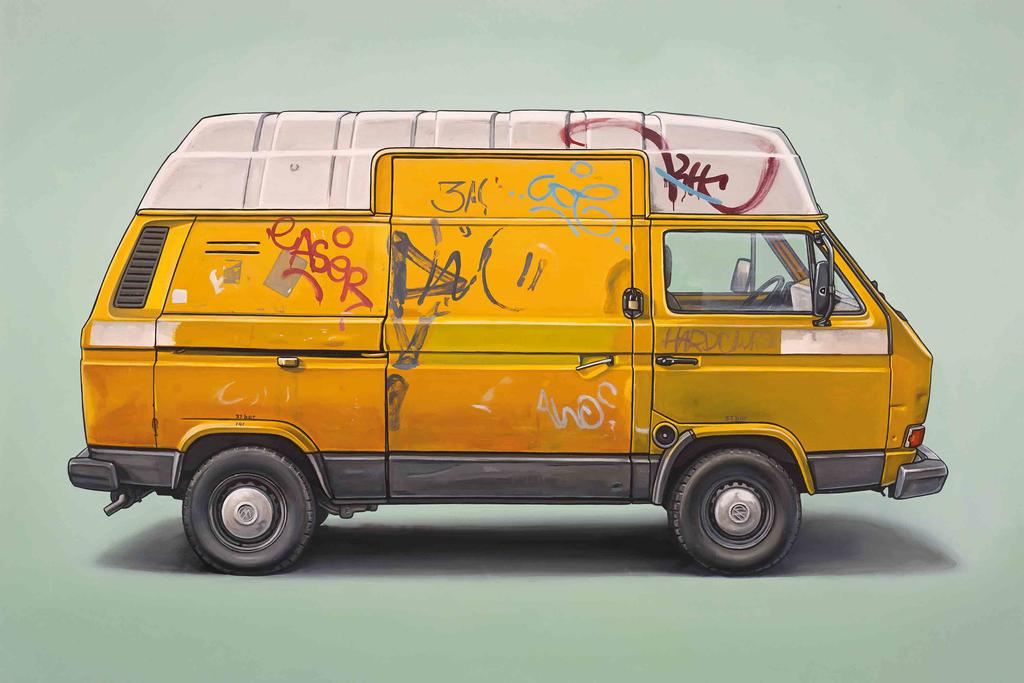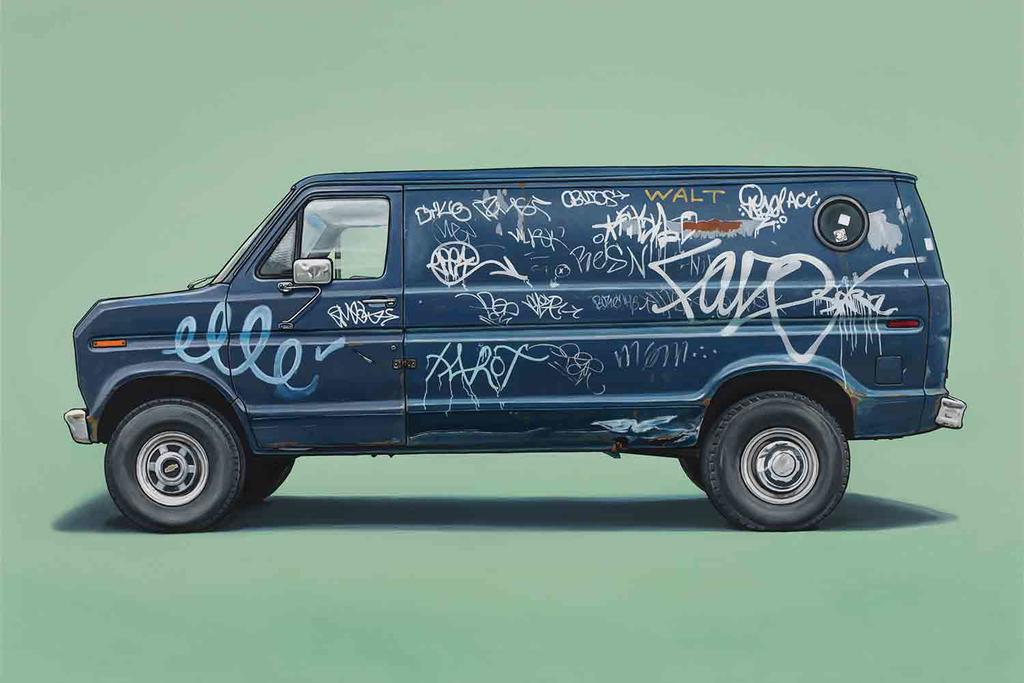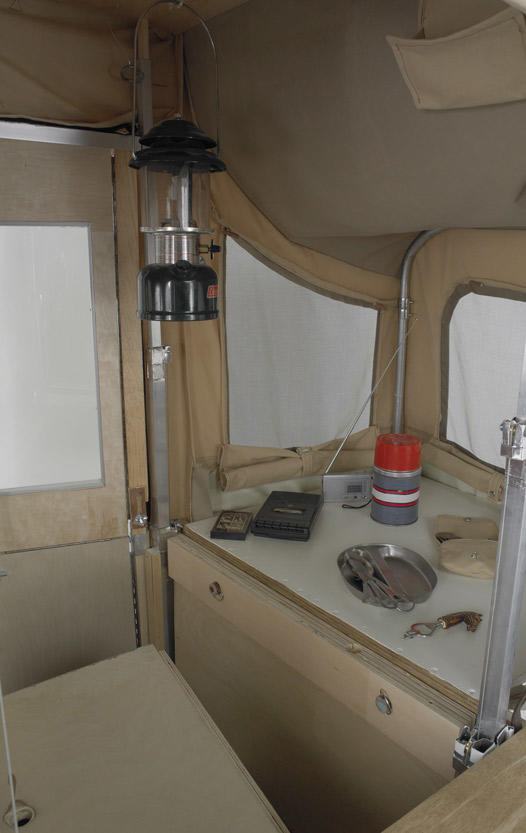

Forging a
Revolutionary Heart
What constitutes a fine set of wheels in this day and age? The work of Portland, Maine-based artist Kevin Cyr provides some interesting food for thought. His vehicle explorations inspire topical reflections on mobility, autonomy, freedom, habitat and DIY self-sufficiency in modern times. Best known for his van “portraiture”, Cyr finds charm in the well-worn utility of working vans and weathered recreational vehicles rusted, dinted and beat up by miles clocked up and stories accrued. He paints selected vans (fan pieces) singly, in profile against a solid colour background. The lustre of oil paint on wood combined with the absence of the van’s natural habitat elevates its stature far beyond its day job and perceived worth. Cyr admires the unaffected manner in which these workhorses go about their chores in a culture that places too much importance on status and appearances.
Besides paintings and drawings, Cyr works on sculptural pieces large and small. In a series of life-size mobile sculptural works, “Camper Bike”, “Camper Kart” and “Little Tag Along”, Cyr pits optimism and autonomy over despair by offering fresh perspectives on shelter, mobility and habitat in uncertain times. He reminds us that the flowers that bloom in the cracks of homes can also appear among the weeds, and on wheels. Cyr’s customized mini RV and pop-up tent structures inspire autonomous, nomadic visions of home on the go in defiance of adversity. In times of economic downturn, the affordable housing crisis and environmental uncertainty, choosing the direction of DIY self-sufficiency, resourcefulness and resilience indeed stirs a revolutionary heart. Doing more with less down the path of little environmental impact might even set you free.
Lodown caught up with Kevin Cyr to find out more.
Kevin, what kind of vehicle captures your attention and demands a portrait?
Character is everything. If a van is too new or if the graffiti is too clean, it’s usually not interesting enough to paint. If it’s too old, it borders on nostalgic and gives an entirely different and unintended meaning to a painting. Working-class vehicles usually have just the right mix of weathered and beaten up. I’m interested in how their exterior tells a story and how they represent a working sector of society that’s less concerned with appearances and more with utilitarian function.
Your “Köpenicker” van (named, if I am right, after the street it was found on) was one you spotted right here in Lodown’s neighbourhood. What are your impressions of Berlin’s vans and is their swagger different from Brooklyn’s own? By the way, do you leave behind your own souvenir tags?
Berlin was a great place to visit. I stayed in the Kreuzberg neighbourhood, would take off early in the morning and bike until it was dark. Coming from the States where all vans are either a Chevy or a Ford, it was cool to see different types of Volkswagen and Mercedes vehicles. There’s no other city that has matched the number of graffiti vans as New York, except for maybe Paris, but Berlin had an interesting range: Volkswagen campers for recreation; really artful stencils—like “Köpenicker”—and Mercedes trucks that were converted into apocalyptic looking campers. I also remember an insanely pristine van that had a “PLEASE RESPECT KEEP THIS OBJECT CLEAN” decal without a single tag on it—that would never happen in New York.
No, I don’t ever tag. I’m interested in cataloguing these vehicles, which are representations of the cities they inhabit. My mark making is reserved for the panel and not the trucks themselves.

What did you learn from your time working as a studio assistant to Kehinde Wiley?
I’ve been thinking about my time with Kehinde a lot since the unveiling of the Obama portrait. I was with him for five years and worked on projects from the VH1 Hip Hop Honors portraits to the incredibly large-scale paintings from his show “Down” at Deitch Projects. It was an invaluable experience to have had an insider view of not only how an artist studio is run but his boundless vision. From a technical perspective, I definitely refined my painting skills—working all day in his studio then heading to my own studio space. I was also extremely lucky to be able to travel to both India and China with his studio. One of the trips to Beijing being the catalyst for an entire body of my work.
The “Camper Bike” kicked off a series of life-size sculptural mobility projects followed by the “Camper Kart” and “Little Tag Along” from the “Home in the Weeds” show. What inspired this initial train of thought? What common threads run through these projects? And how is the series evolving?
The initial idea for the Camper Bike was a result of my time spent in Beijing. I was fascinated with the three-wheeled work-bikes I saw there and how they were being used to transport everything—from building materials, furniture or people. There was an immediate connection to self-reliance and pragmatism. Which led to exploring ideas related to mobility and exploration—using the three-wheeled work bike as a base for a camper—similar to how pick-up trucks can be modified in the US. Almost all of these sculptural projects investigate ideas related to mobility, exploration, habitats, housing, ecology, self-reliance, and utilitarianism.

Let’s discuss “Camper Bike”, the customized Beijing tricycle with RV modification and accompanying series of paintings, in more detail. The additional paintings are heart-warming and optimistic. Can you talk about this notion of “forging a revolutionary heart”?
The Camper Bike was an idea that evolved over the course of three years and three trips to Beijing. It was a slow evolution that took shape with each visit. The first where I had the initial idea of incorporating a camper and a Chinese three-wheeled bicycle; the second where I started to create a series of drawings and paintings with the “Camper Bike” as the main subject; and the third where I decided to build the life-size piece. I initially built the piece solely as a model for paintings, but quickly realized the impact it had as a sculptural piece.
It’s an amalgamation of both Chinese and American cultures—and the items inside are reflective of that; postcards from the Great Wall of China; a copy of John Steinbeck’s “Travels with Charley”; Mao Zedong figurine, Stanley thermos and Coleman camping stove. The title “Camping far out in the wilderness forges a revolutionary heart.” refers to a Chinese propaganda poster’s title, but decontextualized it represents autonomy and self-determination.
The “Camper Kart” is a pop-up camper constructed out of a shopping cart. Could you tell us about this incarnation? Is the shopping cart a reference to the homeless?
The “Camper Kart” was a direct response to the Great Recession in 2008. There was a palpable feeling of doom all around with modern day Hoovervilles popping up across the country. A shopping cart, when seen on the streets, is synonymous with homelessness so it was natural fit. I had also just read “The Road” by Cormac McCarthy and found it interesting that in McCarthy’s post-apocalyptic world the shopping car is the most practical vehicle.
How does the construction process work?
It begins with rough plans. I’ve found that trying to plan every little detail isn’t all that helpful. The building process is mostly trial and error (and a million trips to the hardware store). All the materials are basic items—wood, corrugated metal, windows from local window shops. I’ve tried to salvage old camper parts, but things get too mangled to be useful.
The camper sculptures were definitely designed to be semi-functional which freed me to focus more on form instead of function. They’re more about making a statement rather than creating an actual product, but my goal was always to blur those lines.
Are you working on more projects along these lines? Perhaps a family model, now that you have kids?
I was commissioned to build a mobile gallery/performance bike for Space Gallery in Portland, Maine. The goal is to have a mobile gallery that can be taken out into the community by any artist to either create work or show work. It’s been fun and challenging to create a piece that fully functions, will withstand the elements and be versatile enough for any artist to ride.
“Making do with less” combined with easy access to nature (and often mobility) are in line with the Tiny House movement. What are your thoughts on this movement and how do you see your projects in relation to it?
The Tiny House movement is definitely something that resonates. Freedom from debt and financial burdens, a small environmental footprint, self-sufficiency, etc.—all ideas that are at the root of my sculptural pieces. It’s the practical aspect which isn’t parallel with my work. All of these pieces were created to evoke ideas and not meant to be mass-produced or used for practical purposes.
And lastly, what is on the horizon in 2018?
The mobile gallery bike will be unveiled in June. I have a couple of summer shows lined up, but I’ll mostly be gearing up for a show at Antler Gallery in Portland Oregon.
Words / Amber Grünhäuser
Art / courtesy of Kevin Cyr

















